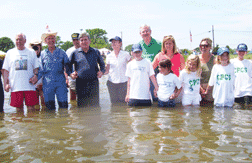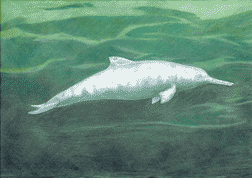Way Downstream
Bernie Fowler waded two feet, two inches into the river he calls “this lovely lady,” the Patuxent, before the white sneakers at the end of the 84-year-old former senator’s long legs disappeared in the brown water. “That’s five inches more than last year, and there are more grasses this year,” said Fowler. His world-famous Sneaker Index of Water Clarity has risen and fallen in 16 years, reaching as high as 44.5 in 1997 and as low as eight inches in 1989. But it’s never reached the five-plus-feet highs of Fowler’s youth, which is why he keeps wading. 
“There’s hope,” Bernie told the 200 friends who braved the early June heat wave to wade with him into bath-warm waters. Among the friends was Congressman Steny Hoyer, who helped bring the Patuxent $4 million worth of hope in this year’s federal Farm Bill. State Sen. Roy Dyson and Del. Sue Kullen also joined the wade-in. But Calvert County Commissioners and Republican office holders stayed away.
Wade-ins have spread across the state. In Annapolis, the index — taken the same second weekend in June — ranged from waist-high 43 inches at Back Creek to calf-covering 20 inches at College Creek; in between, Spa Creek measured 26 inches and Weems Creek 30 inches …
Johnnies featured in last week’s Bay Weekly [Turning Dreaming into Doing: Vol. xvi, No. 23] found unexpected help from readers. “I am off the charts with excitement, joy and happiness,” said Noel Brockett, student at St. John’s College and one of the four Johnnies working to start a new school in the country of Georgia. John Hewins, a retiree who reads Bay Weekly every week when he goes out for lunch, was moved by students’ project to donate $1,000 to their cause. The fundraising went viral when Bill Karpovich of Zenos Inc. sent a link to the article in an email, raising additional funds. The students still need $4,000 to reach their goal. You can still join the revolution in education by donating a dollar to www.liberaleducationgeorgia.org …
Plastic bags get the sack at farmers’ markets in Washington, D.C., and Montgomery County. “Birds, fish, the Earth are all negatively affected by this stream of petroleum-based eco-disaster that we contribute to every day,” wrote farmer Mike Tabor in his monthly newsletter from Licking Creek Bend Farm in Pennsylvania. At his stand, customers must bring their own bags, plastic or reusable, or pay 15 cents for a 100 percent recycled paper sack …

Our Creature Feature comes from Calvert Cliffs, where scientists found the fossil of a new genus and species of extinct dolphin. Jean Hooper, paleontology volunteer and lab intern at Calvert Marine Museum, discovered the partial skull of this dolphin several years ago, and the new species will be named in her honor in the June issue of the Journal of Vertebrate Paleontology. But mum’s the word on the name until 3pm June 12.
Hooper stumbled upon the fossil while walking Calvert Cliffs. The chunk of cliff had fallen to the beach, and Hooper’s trained eye spotted the hard, black fossilized bone set in grayish clay. Back at the lab, she and museum staff discovered that the skull fragment — the part surrounding the blowhole and brain cavity — was different than any other dolphin fossil ever found.
The extinct dolphin is a close relative of the La Plata Dolphin — that’s La Plata as in southeastern South America. The La Plata is the only living species in the family Pontoporiidae, which includes the newly discovered extinct dolphin found in Calvert, plus five other extinct dolphins. During the Miocene epoch, pontoporiid dolphins swam around the world.
“Undoubtedly there are other dolphin skull fragments out there that will erode out,” says Stephen Godfrey, head of the paleontology lab at Calvert Marine Museum. “It’s like forensic paleontology.”